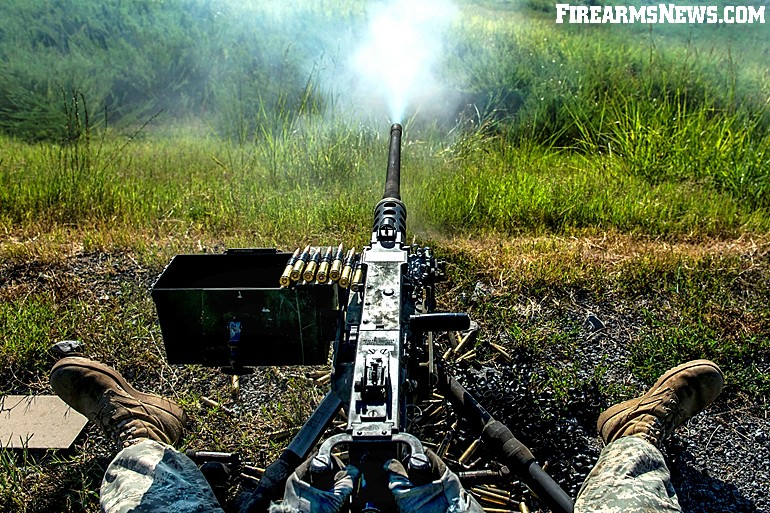
It’s common when someone refers to a subject like the best service pistol or longest serving rifle that they are talking about a certain model of firearm and not an individual unit. When it comes to “longest serving”, it would be hard to rummage through inventories and find an exceedingly old piece. Such is the nature of a firearm used in military service. Normal wear and tear takes their toll. Yet every so often something is found that defies expectation and makes one rethink old notions.
There was a recent discovery at the Anniston Army Depot, where various small arms for the US Army are refurbished and upgraded before returning to unit armorers. An M2 Browning .50 caliber machine gun bearing the serial number 324 arrived from an active duty unit for maintenance and an upgrade to the M2A1 configuration. That low of a production number would have it in the original 1933 run by Colt (although FN in Belgium has been making them continuously since 1933) for an amazing run of 87 years!
Now if you are not familiar with the history of the M2, affectionately called “Ma Deuce”, its life started at the tail end of World War I. The arrival of armored vehicles and heavier aircraft brought forth a call for new weapons to deal with them, as the US Army had nothing effective against either. While others started in 1917 the famed designer John M. Browning came on board in 1918. His plan was to start by enlarging his 1917 .30-caliber machine gun design. In conjunction with Winchester, the new firearm would use a scaled up version of the standard issue .30-‘06 cartridge. The first prototypes were not a resounding success however. They were slow with a 500 rounds per minute rate of fire and a muzzle velocity of just 2,300 feet per second. Needless to say it didn’t meet any criteria.
By 1921 lots of improvements were made in no part thanks to Browning and others studying the German 13.2mm Gewehr Mod 1918 anti-tank rifle. Velocity was improved to over 2,700 fps, and soon experimental prototype .50-caliber M1921 machine guns were being tested. Later A1 and E2, among other models were developed. Now Browning passed away in 1926, but others like S.H. Green continued with the project, and made many advancements. Most importantly, the receiver was designed to be a single base-unit which could be configured in seven different variations, depending upon platform and purpose. By 1933 the M2 was adopted and put into production.

The rest they say is history as by World War II an M2 .50-caliber machine gun was mounted on every variation of vehicle, airplane and warship in the US military. In order to build the thousands needed during that conflict companies like Frigidaire and AC Spark Plug added their manufacturing talent. The M2’s timeless design is easily recognized by any generation to have served since that conflict. Even today there are no plans to replace this design, as there is little currently available that would be truly an upgrade. Today the M2 proudly serves as the heavy machine gun of militaries around the globe. Its estimated that over 3 million M2s have been built. This doesn’t include the numerous variations based on the M2 design.
Serial number 324 was discovered at Anniston Army Depot in 2011 after the US Army called for its older inventory of M2s to be upgraded into the A1 configuration. The most notable change from M2 to M2A1 being fixed headspace and timing. It’s important for a tight and consistent headspace to prevent unsafe chambering or support of a live cartridge. Timing refers to the proper alignment of parts after going through the recoil process. If either is not within accepted specifications the firearm may not run reliably, may not fire or even could even blow up under the worst conditions and injure the soldier. The Army has currently upgraded over 14,000 M2s so far.
Now another surprise was that upon stripping down the receiver for inspection it was found that its tolerances were not just within acceptable values. They were actually in the best set of values for functionality. Meaning No. 324 was in better shape than many of newer examples made recently. Even more amazing is it was the first time this particular unit had been overhauled. So when one thinks that items made over a century ago can’t complete with modern manufacturing processes guess again. Old school machinists on simple equipment can indeed churn out impressively made equipment.
Sadly, because of other field modifications done to No. 324 its likely she will not return to service to continue her impressive run at defending our nation. It’s reported that officials at the Depot are busy going through the complicated process of not only getting it delisted, but saving it from the cutter’s torch. The government seems to prefer destroying history rather than allowing it to be saved. Hopefully it finds a new home as a display piece. Currently its fellow unit, No. 389, is on display at the Small Arms Repair Facility as the oldest surviving M2. It was removed from service several decades ago.
